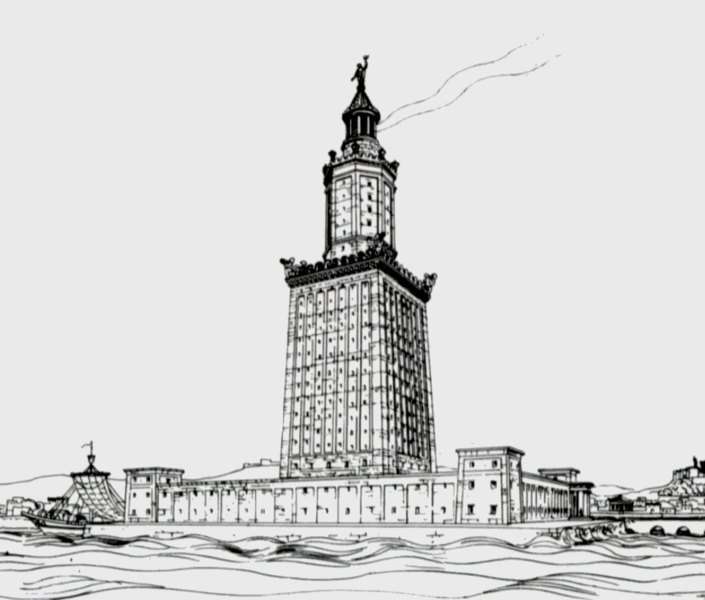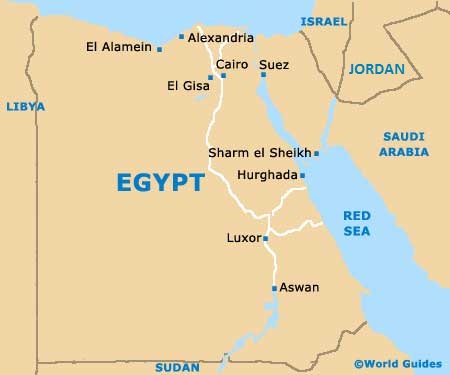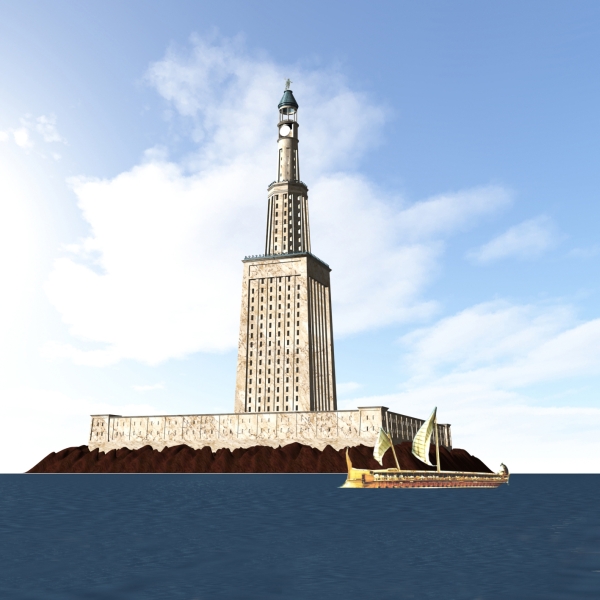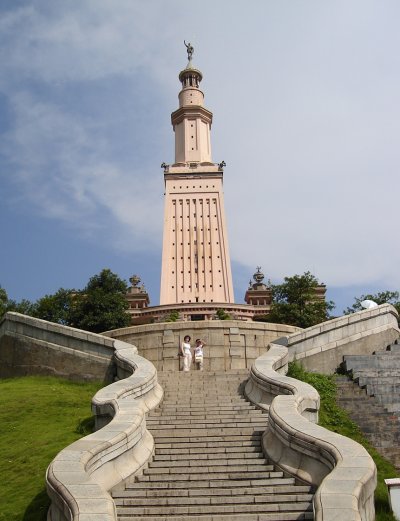<Back to Index>
- Alexandria, Egypt The Pharos of Alexandria, 280 B.C.
PAGE SPONSOR


The Lighthouse of Alexandria, also known as the Pharos of Alexandria (in Ancient Greek, ὁ Φάρος Ἀλεξανδρινóς), was a tower built between 280 and 247 BC on the island of Pharos at Alexandria, Egypt. Its purpose was to guide sailors into the harbor at night time.
With a height variously estimated at somewhere in between 393 and 450 ft (120 and 140 m), it was for many centuries among the tallest man made structures on Earth. It was one of the Seven Wonders of the Ancient World.
Pharos
was a small island just off the coast of Alexandria. It was supposedly
inhabited by people that would destroy any ship that was wrecked off of
its coast. To deter this problem, Ptolemy II had
the lighthouse built. It was linked to the mainland by a man made
connection named the Heptastadion, which thus formed one side of the
city's harbor. The tower erected there guided mariners at night,
through its fire, as well as being a landmark by day.
The lighthouse was completed in the 3rd century BC. After Alexander the Great died of a fever at age 32, Ptolemy Soter announced himself king in 305 BC, and commissioned its construction shortly thereafter. The building was finished during his son Ptolemy Philadelphos's reign.
Strabo reported that Sostratus had a dedication inscribed in metal letters to the "Savior Gods". Later Pliny the Elder wrote that Sostratus was the architect, which is disputed. In the second century AD the satirist Lucian wrote that Sostratus inscribed his name under plaster bearing the name of Ptolemy. This was so that when the plaster with Ptolemy's name fell off, that Sostratus's name would be visible in the stone.
The fullest description of the lighthouse comes from the Arab traveller Abou Haggag Youssef Ibn el-Andaloussi, who visited the structure in 1165 AD. His description runs:
The Pharos rises at the end of the island. The building is square, about 8.5 meters (28 ft) each side. The sea surrounds the Pharos except on the east and south sides. This platform measures, along its sides, from the tip, down to the foot of the Pharos walls, 6.5 meters (21 ft) in height. However, on the sea side, it is larger because of the construction and is steeply inclined like the side of a mountain. As the height of the platform increases towards the walls of the Pharos its width narrows until it arrives at the measurements above. ... The doorway to the Pharos is high up. A ramp about 183 meters (600 ft) long used to lead up to it. This ramp rests on a series of curved arches; my companion got beneath one of the arches and stretched out his arms but he was not able to reach the sides. There are 16 of these arches, each gradually getting higher until the doorway is reached, the last one being especially high.
Constructed from large blocks of light colored stone, the tower was made up of three stages: a lower square section with a central core, a middle octagonal section, and, at the top, a circular section. At its apex was positioned a mirror which reflected sunlight during the day; a fire was lit at night. Extant Roman coins struck by the Alexandrian mint show that a statue of a triton was positioned on each of the building's four corners. A statue of Poseidon stood atop the tower during the Roman period. The Pharos' masonry blocks were interlocked, sealed together using molten lead, to withstand the pounding of the waves.
There are ancient claims the light from the lighthouse could be seen from up to 29 miles (47 km) away.
After the Muslims took over all of Egypt, the top of the Pharos supposedly became a mosque, as the beacon was no longer in working order. The Pharos remained this way until its destruction in the 14th century.
The lighthouse was badly damaged in the earthquake of 956, then again in 1303 and 1323. The two earthquakes in 1303 and 1323 damaged the lighthouse to the extent that the Arab traveler Ibn Battuta reported no longer being able to enter the ruin. Even the stubby remnant disappeared in 1480, when the then Sultan of Egypt, Qaitbay, built a mediæval fort on the former location of the building using some of the fallen stone.
French archeologists led by Jean - Yves Empereur discovered
remains of the lighthouse in late 1994 on the floor of Alexandria's
Eastern Harbor. Some of these remains were brought up and were lying at
the harbor on public view at the end of 1995. A Nova program chronicled the discovery. Subsequent satellite imaging has revealed further remains. It is possible to go diving and see the ruins.
Pharos became the etymological origin of the word 'lighthouse' in Greek (φάρος), many Romance languages, such as French (phare), Italian and Spanish (faro), Romanian (far) and Portuguese (farol) and even some slavic languages like Bulgarian (far).
In 2008 it was suggested that the Pharos was the vertical yardstick used in the first precise measurement of the size of the earth.
The Lighthouse remains a civic symbol of the city of Alexandria and of the Alexandria Governorate with
which the city is more or less coterminous. A stylized representation
of the Lighthouse appears on the flag and seal of the Governorate and on
many public services of the city, including the seal of Alexandria University.
- A well preserved ancient tomb in the town of Abusir, 48 kilometres (30 mi) southwest of Alexandria, is thought to be a scaled down model of the Alexandria Pharos. Known colloquially under various names – the Pharos of Abusir, the Abusir funerary monument and Burg al-Arab (Arab's Tower) – it consists of a 3 story tower, approximately 20 meters (66 ft) in height, with a square base, an octagonal midsection and cylindrical upper section, like the building upon which it was apparently modeled. It dates to the reign of Ptolemy II (285 – 246 BC), and is therefore likely to have been built at about the same time as the Alexandria Pharos.
- The design of minarets in many early Egyptian Islamic mosques followed a similar three stage design to that of the Pharos, attesting to the building's broader architectural influence.
- A replica of the Lighthouse of Alexandria was constructed in the Window of the World Cultural Park in Shenzhen, China.

